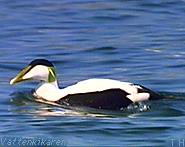
The common limpet is a very effective grazer, but has became uncommon
along the Swedish coastline. When they are found in large numbers,
large algae has difficulting in establishing themselves. Only bladder
wrack has been able to establish itself on its shell!
On protected cliffs and rocky
beaches a smaller amount of alga detrius can be carried way to
other areas. Predators also have a larger choice of prey as they also
have access to the creatures that break down detritus material. Furthermore,
there can be more grazers that attack alga which implies that more
algae is produced in protected areas, but also utilized here. |
Generally it appears as though detrious
material collects on protected beaches, while in exposed areas it
is carried away by the waves and currents. But it is clear that cliffs
and rocky beaches are open systems as those periods when water does
not flow past beaches are few - even on protected beach areas.Water
currents transport detritus, sediment, food and larvae and many creatures
pass by with their own means movement. Because of the large number
of small creatures that exist in dense alga populations, many fish
are attracted here to feed.

Eiders move over large areas and they eat amongst other things small
crustaceans and blue mussels amongst the cliffs and rocks.
|


